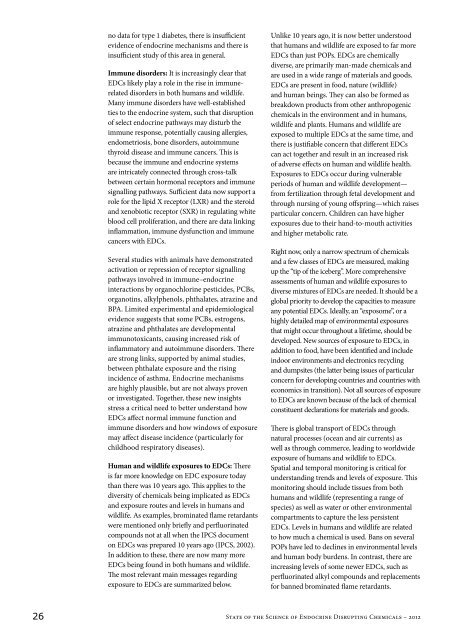Endocrine Disrupting Chemicals 2012 - World Health Organization
Endocrine Disrupting Chemicals 2012 - World Health Organization
Endocrine Disrupting Chemicals 2012 - World Health Organization
You also want an ePaper? Increase the reach of your titles
YUMPU automatically turns print PDFs into web optimized ePapers that Google loves.
no data for type 1 diabetes, there is insufficient<br />
evidence of endocrine mechanisms and there is<br />
insufficient study of this area in general.<br />
Immune disorders: It is increasingly clear that<br />
EDCs likely play a role in the rise in immunerelated<br />
disorders in both humans and wildlife.<br />
Many immune disorders have well-established<br />
ties to the endocrine system, such that disruption<br />
of select endocrine pathways may disturb the<br />
immune response, potentially causing allergies,<br />
endometriosis, bone disorders, autoimmune<br />
thyroid disease and immune cancers. This is<br />
because the immune and endocrine systems<br />
are intricately connected through cross-talk<br />
between certain hormonal receptors and immune<br />
signalling pathways. Sufficient data now support a<br />
role for the lipid X receptor (LXR) and the steroid<br />
and xenobiotic receptor (SXR) in regulating white<br />
blood cell proliferation, and there are data linking<br />
inflammation, immune dysfunction and immune<br />
cancers with EDCs.<br />
Several studies with animals have demonstrated<br />
activation or repression of receptor signalling<br />
pathways involved in immune–endocrine<br />
interactions by organochlorine pesticides, PCBs,<br />
organotins, alkylphenols, phthalates, atrazine and<br />
BPA. Limited experimental and epidemiological<br />
evidence suggests that some PCBs, estrogens,<br />
atrazine and phthalates are developmental<br />
immunotoxicants, causing increased risk of<br />
inflammatory and autoimmune disorders. There<br />
are strong links, supported by animal studies,<br />
between phthalate exposure and the rising<br />
incidence of asthma. <strong>Endocrine</strong> mechanisms<br />
are highly plausible, but are not always proven<br />
or investigated. Together, these new insights<br />
stress a critical need to better understand how<br />
EDCs affect normal immune function and<br />
immune disorders and how windows of exposure<br />
may affect disease incidence (particularly for<br />
childhood respiratory diseases).<br />
Human and wildlife exposures to EDCs: There<br />
is far more knowledge on EDC exposure today<br />
than there was 10 years ago. This applies to the<br />
diversity of chemicals being implicated as EDCs<br />
and exposure routes and levels in humans and<br />
wildlife. As examples, brominated flame retardants<br />
were mentioned only briefly and perfluorinated<br />
compounds not at all when the IPCS document<br />
on EDCs was prepared 10 years ago (IPCS, 2002).<br />
In addition to these, there are now many more<br />
EDCs being found in both humans and wildlife.<br />
The most relevant main messages regarding<br />
exposure to EDCs are summarized below.<br />
Unlike 10 years ago, it is now better understood<br />
that humans and wildlife are exposed to far more<br />
EDCs than just POPs. EDCs are chemically<br />
diverse, are primarily man-made chemicals and<br />
are used in a wide range of materials and goods.<br />
EDCs are present in food, nature (wildlife)<br />
and human beings. They can also be formed as<br />
breakdown products from other anthropogenic<br />
chemicals in the environment and in humans,<br />
wildlife and plants. Humans and wildlife are<br />
exposed to multiple EDCs at the same time, and<br />
there is justifiable concern that different EDCs<br />
can act together and result in an increased risk<br />
of adverse effects on human and wildlife health.<br />
Exposures to EDCs occur during vulnerable<br />
periods of human and wildlife development—<br />
from fertilization through fetal development and<br />
through nursing of young offspring—which raises<br />
particular concern. Children can have higher<br />
exposures due to their hand-to-mouth activities<br />
and higher metabolic rate.<br />
Right now, only a narrow spectrum of chemicals<br />
and a few classes of EDCs are measured, making<br />
up the “tip of the iceberg”. More comprehensive<br />
assessments of human and wildlife exposures to<br />
diverse mixtures of EDCs are needed. It should be a<br />
global priority to develop the capacities to measure<br />
any potential EDCs. Ideally, an “exposome”, or a<br />
highly detailed map of environmental exposures<br />
that might occur throughout a lifetime, should be<br />
developed. New sources of exposure to EDCs, in<br />
addition to food, have been identified and include<br />
indoor environments and electronics recycling<br />
and dumpsites (the latter being issues of particular<br />
concern for developing countries and countries with<br />
economics in transition). Not all sources of exposure<br />
to EDCs are known because of the lack of chemical<br />
constituent declarations for materials and goods.<br />
There is global transport of EDCs through<br />
natural processes (ocean and air currents) as<br />
well as through commerce, leading to worldwide<br />
exposure of humans and wildlife to EDCs.<br />
Spatial and temporal monitoring is critical for<br />
understanding trends and levels of exposure. This<br />
monitoring should include tissues from both<br />
humans and wildlife (representing a range of<br />
species) as well as water or other environmental<br />
compartments to capture the less persistent<br />
EDCs. Levels in humans and wildlife are related<br />
to how much a chemical is used. Bans on several<br />
POPs have led to declines in environmental levels<br />
and human body burdens. In contrast, there are<br />
increasing levels of some newer EDCs, such as<br />
perfluorinated alkyl compounds and replacements<br />
for banned brominated flame retardants.<br />
26 State of the Science of <strong>Endocrine</strong> <strong>Disrupting</strong> <strong>Chemicals</strong> – <strong>2012</strong>
















